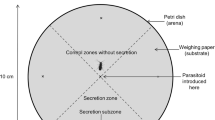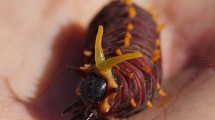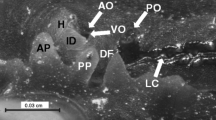Abstract
The subsocial tenebrionid Parastizopus armaticeps Pér. is parasitized by the closely related Eremostibes opacus Koch (Coleoptera: Tenebrionidae). We found that the pygidial defensive secretions of both species are similar and contain a mixture of 1,4-benzoquinones, 1-alkenes, and monoterpene hydrocarbons. The 1-alkenes are dominated by 1-undecene, with admixtures of 1-tridecene in both species and 1-pentadecene in P. armaticeps only. Methyl- and ethyl-1,4-benzoquinone are the major quinones of the secretions of both species. The monoterpene fractions consist of (−)-α-pinene, (−)-camphene, sabinene, (−)-β-pinene, and (−)-limonene. Volatiles trapped with Porapak Q at the entrance to the breeding burrows of P. armaticeps were identified as components of the defensive secretion. However, in contrast to the secretion, the 1,4-benzoquinones were almost completely absent in the volatiles. Bioassays investigating attraction showed that the cleptoparasite E. opacus was drawn to the monoterpene hydrocarbons, produced by P. armaticeps, and deterred by the 1,4-benzoquinones. The 1-alkenes had no effect. Among the monoterpenes, only (−)-camphene was attractive to E. opacus. This is one of the rare cases of chemical exploitation of defensive allomones, and the first based on odor homology. We have drawn an evolutionary scenario including various functional changes in the defensive secretion compounds, leading to the kairomonal exploitation.


Similar content being viewed by others
References
Aldrich, J. R. 1999. Predators, pp. 357–381, in J. Hardie and A. K. Minks (eds.). Pheromones of Non-Lepidopteran Insects Associated with Agricultural Plants. CABI Publishing, Oxon.
Aldrich, J. R. and Barros, T. M. 1995. Chemical attraction of male crab spiders (Araneae, Thomisidae) and kleptoparasitic flies (Diptera, Milichiidae and Chloropidae). J. Arachnol. 23:212–214.
Aldrich, J. R., Carroll, S. P., Oliver, J. E., Lusby, W. R., Rudmann, A. A., and Waters, R. M. 1990. Exocrine secretions of scentless plant bugs: Jadera, Boisea and Niesthrea species (Hemiptera: Heteroptera: Rhopalidae). Biochem. Syst. Ecol. 18:369–376.
Attygalle, A. B., Blankespoor, C. L., Meinwald, J., and Eisner, T. 1991. Defensive secretion of Tenebrio molitor (Coleoptera: Tenebrionidae). J. Chem. Ecol. 17:805–810.
Blum, M. S. 1996. Semiochemical parsimony in the Arthropoda. Annu. Rev. Entomol. 41:353–374.
Bowers, W. W. and Borden, J. H. 1992. Attraction of Lasconotus intricatus Kraus. (Coleoptera: Colydiidae) to the aggregation pheromone of the four-eyed spruce bark beetle Polygraphus rufipennis Kirby (Coleoptera: Scolytidae). Can. Entomol. 124:1–5.
Brand, J. M., Blum, M. S., Lloyd, H. A., and Fletcher, D. J. C. 1974. Monoterpene hydrocarbons in the poison gland secretion of the ant Myrmicaria natalensis (Hymenoptera: Formicidae). Ann. Entomol. Soc. Am. 67:525–526.
Brown, W. V., Doyen, J. T., Moore, B. P., and Lawrence, J. F. 1992. Chemical composition and taxonomic significance of defensive secretions of some Australian Tenebrionidae (Coleoptera). J. Aust. Entomol. Soc. 31:79–89.
Eisner, T., Eisner, M., and Deyrup, M. 1991. Chemical attraction of kleptoparasitic flies to heteropteran insects caught by orb-weaving spiders. Proc. Natl. Acad. Sci. USA 88:8194–8197.
Geiselhardt, S. F., Geiselhardt, S., Peschke, K. in press. Chemical mimicry of cuticular hydrocarbons—how does Eremostibes opacus gain access to breeding burrows of its host Parastizopus armaticeps (Coleoptera, Tenebrionidae). Chemoecology.
Gnanasunderam, C., Young, H., and Hutchins, R. F. N. 1981. Defensive secretions of New Zealand tenebrionids: I. Presence of monoterpene hydrocarbons in the genus Artystona (Coleoptera, Tenebrionidae). J. Chem. Ecol. 7:889–894.
Gush, T. J., Bentley, B. L., Prestwich, G. D., and Thorne, B. L. 1985. Chemical variation in defensive secretions of four species of Nasutitermes. Biochem. Syst. Ecol. 13:329–336.
Happ, G. M. 1968. Quinone and hydrocarbon production in the defensive glands of Eleodes longicollis and Tribolium castaneum (Coleoptera, Tenebrionidae). J. Insect Physiol. 14:1821–1837.
Hein, E., Rasa, O. A. E., and Ockenfels, P. 1996. Odour profile congruity in two closely related desert tenebrionid beetles: homology as the basis for a cleptoparasitic relationship? Chemoecology 7:156–161.
Helsberg, D. 1994. Wüstenschwarzkäfergemeinschaften: Der Einfluß von Aggregationsbildung auf den relativen Wasserverlust von Individuen. Unpublished, Diploma Thesis, University of Bonn.
Kielty, J. P., Allen-Williams, L. J., Underwood, N., and Eastwood, E. A. 1996. Behavioral responses of three species of ground beetles (Coleoptera: Carabidae) to olfactory cues associated with prey and habitat. J. Insect Behav. 9:237–250.
Krell, F.-T., Schmitt, T., and Linsenmair, K. E. 1997. Diplopod defensive secretions as attractants for necrophagous scarab beetles (Diplopoda; Insecta, Coleoptera: Scarabaeidae). Entomol. Scand., Suppl. 51:281–285.
Markarian, H., Florentine, G. J., and Pratt Jr., J. J. 1978. Quinone production of some species of Tribolium. J. Insect Physiol. 24:785–790.
Mattiacci, L., Vinson, S. B., Williams, H. J., Aldrich, J. R., and Bin, F. 1993. A long-range attractant kairomone for egg parasitoid Trissolcus basalis, isolated from defensive secretion of its host, Nezara viridula. J. Chem. Ecol. 19:1167–1181.
Moore, B. P. 1968. Volatile terpenes from Nasutitermes soldiers (Isoptera, Termitidae). J. Insect Physiol. 10:371–375.
Peschke, K. and Eisner, T. 1987. Defensive secretion of the tenebrionid beetle, Blaps mucronata: Physical and chemical determinants of effectiveness. J. Comp. Physiol., A 161:377–388.
Peschke, K. and Metzler, M. 1982. Defensive and pheromonal secretion of the tergal gland of Aleochara curtula I. The chemical composition. J. Chem. Ecol. 8:773–783.
Powell, W. 1999. Parasitoid hosts, pp. 405–427, in J. Hardie and A. K. Minks (eds.). Pheromones of Non-Lepidopteran Insects Associated with Agricultural Plants. CABI Publishing, Oxon.
Prendeville, H. R. and Stevens, L. 2002. Microbe inhibition by Tribolium flour beetles varies with beetles species, strain, sex, and microbe group. J. Chem. Ecol. 28:1183–1190.
Rasa, O. A. E. 1990. Evidence for subsociality and division of labor in a desert tenebrionid beetle Parastizopus armaticeps Peringuey. Naturwissenschaften 77:591–592.
Rasa, O. A. E. 1994. Parabiosis and its proximate mechanisms in four Kalahari desert tenebrionid beetles. Ethology 98:137–148.
Rasa, O. A. E. 1996. Interspecific association in desert tenebrionid beetles: a cleptoparasite does not affect the host's reproductive success, but that of its offspring. Naturwissenschaften 83:575–577.
Rasa, O. A. E. and Endrödy-Younga, S. 1997. Intergeneric associations of stizopinid tenebrionids relative to their geographical distribution (Coleoptera: Tenebrionidae: Opatrini: Stizopina). Afr. Entomol. 5:231–239.
Rosengaus, R. B., Lefebvre, M. L., and Traniello, J. F. A. 2000. Inhibition of fungal spore germination by Nasutitermes: Evidence for a possible antiseptic role of soldier defensive secretions. J. Chem. Ecol. 26:21–39.
Schmitt, T., Krell, F.-T., and Linsenmair, K. E. 2004. Quinone mixture as attractant for necrophagous dung beetles specialized on dead millipedes. J. Chem. Ecol. 30:731–740.
Stowe, M. K., Turlings, T. C. J., Loughrin, J. H., Lewis, W. J., and Tumlinson, J. H. 1995. The chemistry of eavesdropping, alarm, and deceit. Proc. Natl. Acad. Sci. USA 92:23–28.
Tannert, W. and Hien, B. C. 1973. Nachweis und Funktion eines “Versammlungsduftstoffes” und eines “Alarmduftstoffes” bei Blaps mucronata Latr., 1804 (Coleopt.-Tenebrionidae). Biol. Zbl. 92:601–612.
Teerling, C. R., Gillespie, D. R., and Borden, J. H. 1993. Utilization of western flower thrips alarm pheromone as a prey-finding kairomone by predators. Can. Entomol. 125:431–437.
Tschinkel, W. R. 1975. A comparative study of the chemical defensive system of tenebrionid beetles—Chemistry of the secretions. J. Comp. Physiol. 21:753–783.
Vinson, S. B. 1984. Parasitoid–host relationship, pp. 205–233, in W. J. Bell, and R. T. Cardé (eds.). Chemical Ecology of Insects. Chapman and Hall, London.
Weseloh, R. M. 1981. Host location by parasitoids, pp. 79–95, in D. A. Nordlund, R. L. Jones, and W. J. Lewis (eds.). Semiochemicals: their Role in Pest Control. John Wiley, New York.
Zhu, J., Cossé, A. A., Obrycki, J. J., Boo, K. S., and Baker, T. C. 1999. Olfactory reactions of the twelve-spotted lady beetle, Coleomegilla maculata and the green lacewing, Chrysoperla carnea to semiochemicals released from their prey and host plant: Electroantennogram and behavioral responses. J. Chem. Ecol. 25:1163–1177.
Zuk, M. and Kolluru, G. R. 1998. Exploitation of sexual signals by predators and parasitoids. Quart. Rev. Biol. 73:415–438.
Acknowledgments
We are grateful to Thomas Schmitt for synthesis of isopropyl- and propyl-1,4-benzoquinone as reference standards and to Sonia Whitlow, Stefanie Geiselhardt, and two anonymous reviewers for helpful comments on the manuscript. This work was supported by the Deutsche Forschungsgemeinschaft, Bonn (Ra 338/5-4, Pe 231/13-1,2).
Author information
Authors and Affiliations
Corresponding author
Rights and permissions
About this article
Cite this article
Geiselhardt, S., Szepat, T., Rasa, O.A.E. et al. Defensive Secretion Components of the Host Parastizopus armaticeps as Kairomones for the Cleptoparasite Eremostibes opacus . J Chem Ecol 32, 767–778 (2006). https://doi.org/10.1007/s10886-006-9028-9
Received:
Revised:
Accepted:
Published:
Issue Date:
DOI: https://doi.org/10.1007/s10886-006-9028-9




